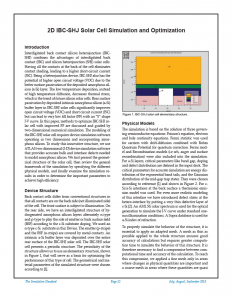2D IBC-SHJ Solar Cell Simulation and Optimization
Introduction
Interdigitated back contact silicon heterojunction (IBC-SHJ) combines the advantages of interdigitated back contact (IBC) and silicon heterojunction (SHJ) solar cells. Having all the contacts at the back of the cell eliminates contact shading, leading to a higher short-circuit current (JSC). Being a heterojunction device, IBC-SHJ also has the potential of higher open circuit voltage (VOC) due to the better surface passivation of the deposited amorphous silicon (a-Si) layer. The low temperature deposition, instead of high temperature diffusion, decreases thermal stress, which is the trend of future silicon solar cells. Rear surface passivation by deposited intrinsic amorphous silicon (a-Si) buffer layer in IBC-SHJ solar cells significantly improves open circuit voltage (VOC) and short circuit current (JSC) but can lead to very low fill factor (FF) with an “S” shape J-V curve. In this paper, methods to optimize IBC-SHJ solar cell with improved FF are discussed and guided by two-dimensional numerical simulation. The modeling of the IBC-SHJ solar cell requires device simulation software operating in two dimensions and incorporating amorphous silicon. To study this innovative structure, we use ATLAS two-dimensional (2-D) device simulation software that provides accurate bulk and interface defects needed to model amorphous silicon. We first present the geometrical structure of the solar cell, then review the general framework of the simulation by specifying the different physical models, and finally examine the simulation results in order to determine the important parameters to achieve high efficiency.



